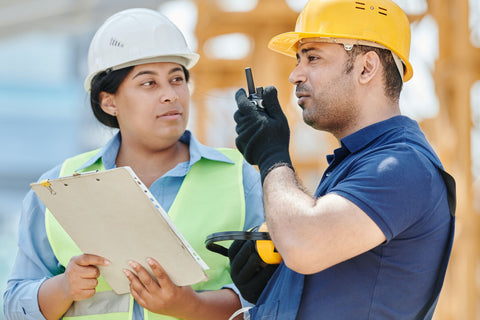Choosing the right two-way radio for your business is an important decision. Factors like cost, features, licenses, and types of radio all play a role in determining which two-way radio will benefit your business the most.
In this article we discuss the different types of radios available, who can benefit from two-way radios, and the different elements to consider when narrowing down the radios. We hope this article helps you make your most informed decision on what two-way radio is best for your business.
The Types of Radios
There are two basic ways to break down the different types of radios—by purpose and by grade. There are four different two-way radio grades. The first is “consumer grade” which is a basic walkie talkie. These radios are typically for recreational use only.
Business grade is the next level of two-way radios. These radios are designed for retail stores, offices, grocers, restaurants, museums, and more. The last grade meant for the public is commercial grade two-way radios. This grade of radio is built to be durable and have up to 512 channels. They are made for factories, universities, construction sites, and distribution centers.
Public safety grade radios are made specifically for emergency responders to use during their job. These two-way radios are equipped with special features like encryption.
The next way to choose which radio works best for your situation is by purpose. There are three different types of two-way radios for three different purposes—portable radios, mobile radios, and desktop base station radios.
Portable radios are handheld two-way radios that can transmit and receive voice communications. These radios can be useful in almost any job setting but are ideal for those listed below:
- Golf courses
- Healthcare
- Hotels and Resorts
- Manufacturing
- Schools
- Summer Camps
- Museums
- Restaurants
- Retail
Mobile radios are made to be installed inside of vehicles. They are connected to an antenna that is mounted to the roof of the vehicle. These radios can transmit and receive; moreover, with the external antenna, the radios can cover long distances.
Mobile radios are great for businesses that have a lot of drivers on the road. For instance:
- Deliver personnel
- Bus Drivers (Public transportation or Public education)
- College and University Public Safety
- Manufacturing
- Security Teams
- First Responder Vehicles (Police officers, firefighters, EMTS, and more)
- Tow-Truck drivers
There are many industries that can benefit from mobile radios.
The last form of radio are desktop base station two-way radios. These radios are very reliable, but they do come with several downsides like—they take up significant space, need to plug in for power, and they are heavy.
This form of two-way radio is often preferred for administrative assistants, admin in schools, and others who direct staff from their desk.
Desktop radios are best used by:
- K-12 School front office administrators
- Colleges and Universities
- Manufacturing
- Security (Front Desks)
- Hotels
Who can benefit from radios
Many different businesses and industries can benefit from using two-way radios. This technology helps streamline communication, which is often a top priority for educators, construction crews, industrial plants, and more.
Educators can use two-way radios when moving children throughout a school building, during recess, on field trips, and more. With two-way radios, the administration and teachers can be certain that lines of communication will not drop or be interrupted. Moreover, they do not have to use personal technology like cellular phones which can have low battery life and low reliability in certain areas.
Construction crews are also big contenders for benefiting from using two-way radios. Those on construction sites will specifically benefit from features like hands-free communication, long battery life, and durability. Two-way radios are built to provide those features and so much more.
Industrial plants and manufacturers are another area of business that would improve communication quality and efficiency with two-way radios. This technology can be paired with a variety of accessories that can be used hands-free, protect hearing in loud environments, and ensure clear and consistent communication.
Overall, two-way radios are built to solve the communication challenges that many businesses and industries face.
Things to Consider When Buying a Business Radio
There are several factors that a business should consider when determining what two-way radios are best for them and their team.
- Analog vs Digital?
- UHF or VHF?
- What special features do you need?
- What level of durability is necessary?
- What is your budget?
- How many channels will you need?
- Will you need an FCC license?
The questions above can be challenging to answer if you don’t know the terminology behind two-way radios. Below, we briefly break down these questions and link to our other articles that do a deeper dive into the subjects. We hope the following will arm you with the knowledge to make an informed decision on what two-way radios are right for your team.
Analog vs Digital
Analog is the time tested and traditional technology for two-way radios. It was designed to be reliable and user friendly. Because analog radios are so straightforward there is no need for training or making time for a learning curve.
However, as time moves forward the communication solutions businesses need are more complex than reliability. With digital radios, more communication obstacles can be overcome. Digital radios allow for a wider range of coverage, higher voice quality, GPS tracking, encryption and security, greater capacity, and longer battery life.
Those that are looking to use all the “bells and whistles” that a two-way radio can offer should lean towards digital technology. Whereas, those that are more prone to needing the basics of reliable communication may only need analog technology.
UHF vs VHF
The first thing to know is UHF is ultra-high frequency and VHF is very-high frequency. The three biggest differences between UHF and VHF are reception distance/quality, battery life, and cost.
UHF produces smaller radio waves which break through barriers like trees and rocks better than the wider radio waves that VHF produces. Both frequencies reach similar distances; however, VHF can be spotty when there are many barriers in between the two-way radios that are communicating. Therefore, UHF is commonly used by public safety personnel or in manufacturing facilities where there are a lot of physical obstructions for radio waves. On the other hand, VHF is often used by boaters and marinas because there are not as many physical obstacles.

Large work sites will benefit from UHF technology because it will have a higher probability of being consistent even amongst all of the obstacles. When choosing between UHF and VHF the biggest question you need to ask yourself is “Will I be using my radios inside or outside and what kind of obstacles will be between the communicating radios?”
A primary downside to UHF radios is a shorter battery life because it uses more energy to produce more radio waves. Moreover, UHF radios tend to be more expensive than VHF because of the higher complexity of the technology.
To learn more about the differences between UHF and VHF read here.
Special features
When choosing the right two-way radio for your business, you will need to determine what, if any, special features you will require. Two-way radios can come with many amazing features. For instance, they can have built-in GPS, Bluetooth connection, SOS signals, encryption, and more.
The built-in GPS is useful for those that are planning on using their two-way radios in rural areas. For instance, camp counselors, search and rescue teams, and park rangers would highly benefit from radios that have built-in GPS. Not only will it help with basic navigation, but it could also help during emergencies because users can supply their exact location to responders.
Bluetooth is a great feature for anyone looking to use accessories with their two-way radio. Accessories can include hearing protection headsets, earpieces, boom microphone headsets, PTT capabilities, and more. These accessories are great for hands-free communication which is optimal in environments where people are working with their hands like in construction sites.
Two-way radios can also be equipped with encryption that acts as a layer of security to keep communications private. This feature is extremely useful for sensitive areas of work like public safety, hospitals, and education.
Keep in mind, if you are on a budget, the more features the two-way radio comes with, the higher the cost. Consequently, it is best to know what features are a priority for your team before making a purchase.
Durability
Durability is something many businesses will want to take into consideration. If your business is retail then you may not need a two-way radio with high durability; however, if you’re using the radio in mines, construction sites, or hazardous areas, you may be looking for something with great ratings.
For those that need a durable two-way radio, a key phrase to look for is “intrinsically safe”. If a two-way radio is intrinsically safe, then it is designed to be incapable of igniting combustible or flammable material in the air.
Those that are working in hazardous areas need an intrinsically safe radio—those that work in dangerous environments like construction, the military, and others need a rugged radio. These radios are built to IP67 ratings which means they can be submersed in water, can endure dust and humidity, can work through cold or hot temperature shocks, and more. To decide what radio is right for your business, you need to determine what environment the radio will be working in.
Cost
The cost of two-way radios can vary depending on their parameters. In general, high-end radios with more features will cost more than low end radios that have less features.
If your business has a budget to follow, strive for lower end radios. This does not mean they are lower quality with durability and communication abilities, they just have different specifications. You can still have a great performing radio at a low cost it just may not come with as many of the special features above.
Additional costs after purchasing your two-way radio include accessories, replacement batteries, antennas, and if an FCC license is needed. Most FCC licenses are good for 10 years and cost $35 so it is a worthy investment.
Will you need an FCC License?
An FCC license is a license through the Federal Communications Commission that allows for the operation of certain two-way radios.
The Federal Communications Commission monitors the different frequencies that require a license to use. GMRS two-way radios require a license to be operated because they can use special frequencies.
There are radios that do not require a license and are called “license free radios”. License free radios are two-way radios that can be operated without a license and work on a fixed band. These two-way radios come pre-programmed to automatically work on a fixed band so they can be operated right out of the box.
Fixed band means radio communication between two specific points. These radios tend to have a smaller coverage area between radios—typically 1 to 2 miles. Those that are using their radios in small locations may opt for license free radios so that they do not have to worry about license fees or maintenance.
The general rule for needing an FCC license is the stronger the radio, the higher the need for a license. Wattage determines if you need a license, typically under 2 watts you won’t need a license.
How many channels will you need?
The next way to determine what kind of radio you need is to know how many channels you will use. One channel will work if you want everyone on the same channel to communicate. However, if you are looking for departments to have their own channels, you will need more than one.
For those using radios on big construction sites, they will want to have multiple channels to have smaller groups communicating. Businesses like retail and smaller operations will benefit from only one channel so that everyone working is on the same page.
XpressComm
The XpressComm radio has a variety of useful features for different businesses. It comes with 32 channels, is IP67 rated, has a 40% longer battery life, does require an extra license for operation, and works on UHF and VHF frequencies.
The XpressComm is integrated with the latest technology that lets you operate in both analog and digital modes. It comes with texting, GPS, VOX, up to 1000 contacts, emergency button, antenna, and belt clip. Overall, the XpressComm is made to reach a wide range of businesses’ needs without breaking the bank by costing a reasonable $375.
Midland Biztalk
The Midland Biztalk series was specifically created for business owners. The Biztalk MB400, BR200, and BR180 all operate on the business band.
These radios do require a license but guarantee privacy and fewer interruptions on your assigned frequencies. The Biztalk series are useful for retail stores, hospitality, amusement parks, restaurants, and more.
They are also compatible with other business radio models if the other models also use the UHF business band and operate between 450-470 MHz.
Midland Biztalk radios range between $100-$130.
We hope this article gave you the necessary information to choose which radio is right for your business and team. Here at First Source Wireless, we want to help arm you with knowledge to make the right decisions for your business’ communications technology.






